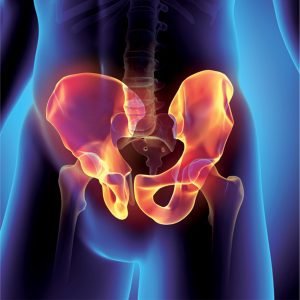By Lam Nguyen, MD, Orthopedic Surgeon
 Hip and spine pathologies can lead to severe disability, and they often occur in combination. Because symptoms of hip and spine conditions can significantly overlap and mimic one another, diagnosing and treating patients with hip and spine problems can be very challenging. Patients with both hip and lumbar spine pathology commonly have low back pain (LBP) with associated buttock, groin, thigh, and, possibly, knee pain. Understanding where the symptoms are coming from can minimize the risk of delayed diagnosis and treatment.
Hip and spine pathologies can lead to severe disability, and they often occur in combination. Because symptoms of hip and spine conditions can significantly overlap and mimic one another, diagnosing and treating patients with hip and spine problems can be very challenging. Patients with both hip and lumbar spine pathology commonly have low back pain (LBP) with associated buttock, groin, thigh, and, possibly, knee pain. Understanding where the symptoms are coming from can minimize the risk of delayed diagnosis and treatment.
Obtaining a thorough history from the patient is one of the keys to discerning the cause of the pain. Traditionally, physicians are taught that hip osteoarthritis mainly causes groin pain, and sometimes thigh and knee pain, but not typically pain below the knee. However, research has shown that hip osteoarthritis can result in buttock pain (75%), posterior thigh pain (43%), shin (47%) and calf (29%) pain. Generally, difficulty with putting on shoes and socks, clipping toe nails, or getting in and out of a car are associated with a hip problem. On the other hand, patients with lumbar spine conditions typically complain of burning or electric type pain shooting down the leg to the toes (sciatica) that may or may not be associated with tingling/numbness. Patients with lumbar stenosis (narrowing of the spinal canal leading to pinching of the nerve roots) will typically report the need to lean over a shopping cart at the grocery store, or the need to frequently sit down to obtain relief of back, buttock, and leg after prolonged standing or walking.
A compressive physical examination is requisite to hone in on the primary cause of the symptoms. Patients with pain coming from a hip pathology will typically have exacerbation of groin and thigh pain with provocative rotation of the hip joint. These patients may also exhibit markedly decreased range of motion of the hip joint. Focal tenderness to palpation over the lateral hip area may indicate inflammation of the trochanteric bursa. On the other hand, the presence of altered sensation or atrophy and weakness of the muscles around the buttocks and lower extremities are more likely to be associated with a problem arising from the spine. Furthermore, the presence of asymmetric reflexes, or nerve root tension signs (exacerbation of the sciatica pain when the physician raises the patient’s fully straightened leg) is indicative a spinal pathology.
Imaging workup may include x-rays, MRI and/or CT of the spine and the pelvis/hips. When imaging demonstrates significant pathology in the spine but not the hip, or vice versa, then the diagnosis becomes obvious. Unfortunately, it is not uncommon for imaging workup to reveal pathologies in both the spine and the hip. In this case, it may not be possible to diagnose the primary source of the pain based on imaging data. An astute physician may order specialized testing such as nerve conduction testing or specific types of diagnostic (and potentially therapeutic) injections into the hip area or the spine to assess the patient’s response.
For example, if a patient receives greater than 90% relief of their symptoms after a hip joint injection, then it can be deduced that the primary source of the pain is coming from the hip joint, and treatment should be targeted to the hip.
It is important that the patient and the surgeon understand the concept that concurrent spine and hip symptoms do exist. Determining which pathology to surgically address first should be a joint decision made between the patient and the surgeon. Both the patient and the surgeon should also understand that after one pathology is managed, the treatment of the other pathology may become necessary because of persistent pain. The recognition of both entities may help reduce the likelihood of misdiagnosis, and the management of both entities in the appropriate sequence may help reduce the likelihood of persistent symptoms.
If you have concerns about having an arthritic hip joint, call and schedule an appointment with Dr. Edward R. Dupay, Jr. He has 34 years of extensive experience doing total hip replacements.
To schedule your appointment, please call Orthopedic Associates of Southwest Florida at 239-768-2272, or ask your physician for a referral.
Edward R. Dupay, Jr, DO
Board Certified
Dr. Dupay graduated from Xavier University in Cincinnati, Ohio. He received his Doctor of Osteopathy at the University of Health Sciences, College of Osteopathic Medicine in Kansas City, Missouri.
Dr. Dupay completed his Internship and Orthopedic Surgery Residency at Flint Osteopathic Hospital in Flint, Michigan. Dr. Dupay has been in the Fort Myers / Cape Coral area since 1987. Dr. Dupay enjoys seeing the “Weekend Warrior” athlete, as well as all patients suffering from crippling osteoarthritis.









